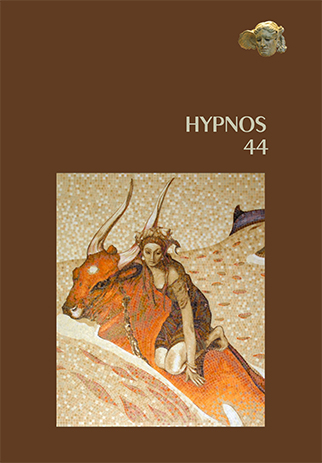El verbo ειμι en Parménides: entre epistemología y ontología
Keywords:
Parménides, verbo εἰμί, ontologÃa y epistemologÃaAbstract
A partir de la propuesta de Charles H. Kahn sobre identificar como primario el valor veritativo del verbo εἰμί en el poema de Parménides, este artículo se propone dar cuenta del desarrollo del argumento central de su poema en términos de una transición de un nivel epistemológico a uno ontológico. Se argumentará que dicho recorrido sigue el despliegue semántico del verbo εἰμί, que avanza desde dicho sentido inicial veritativo hasta poner en primer plano el valor existencial, en ese entonces todavía incipiente. A su vez, se mostrará cómo cada uno de estos dos niveles interpretativos se traduce, respectivamente, en estructura lógica de la realidad y estructura fáctica y concreta, las cuales confluyen en el concepto totalizador ἐόν.References
ÁLVAREZ SALAS, O. Intelectuales y poetas en la era presocrática: diálogo y polémica. Nova Tellus, 28(2), 2010, pp. 21–68.
BARNES, J. The Presocratic Philosophers. London and New York: Routledge, 1982.
BERNAYS, J. Gesammelte Abhandlungen, vol. I. (H. Usener, Ed.). Berlin, 1885.
CORDERO, N. L. Les deux chemins de Parménide dans les fragments 6 et 7. Phronesis, 24(1), 1979, pp. 1–32.
________ L’histoire du texte de Parmenide. En Études sur Parménide: Problèmes d’interprétation, t. II (pp. 3–24). París: Vrin, 1987.
________ Siendo, se es. La tesis de Parménides. Buenos Aires: Biblos, 2005.
CORNFORD, F. M. (1939). Plato and Parmenides. London: Kegan Paul, Trench, Trubner & Co.
DIELS, H. Parmenides Lehgedicht. (G. Reimer, Ed.) (2a. ed., r). Berlin, 1897.
DIELS, H., & KRANZ, W. Die Fragmente der Vorsokratiker (6a.). Berlin: Weidmannsche Verlagsbuchhandlung, 1960.
GÓMEZ-LOBO, A. (1985). Parmenides. Buenos Aires: Charcas, 1985.
GUTHRIE, W. K. C. (1962). A History of Greek Philosophy: Volume 2. The Presocratic Tradition from Parmenides to Democritus. Cambridge University Press, 1962.
HARRIS, Z. S. Transformational Theory. Language, 41, 363–401, 1965.
KAHN, C. H. The Verb `Be´in Ancient Greek. Indianapolis: IN Hackett Pub. Co, 2003.
________ Essays on Being. New York: Oxford University Press Inc, 2009.
KRANZ, W. Über Aufbau und Bedeutung des parmenideischen Gedichts. Sitzungsberichte des königlichen preussischen Akademie der Wissenschaften, 2 (juli-dezember), 1916, pp. 1158–1176.
MANETTI, G. Theories of the Sign in Classical Antiquity. Bloomington and Indianapolis: Indiana University Press, 1993.
MANSFELD, J. (1964). Die Offenbarung des Parmenides un die meschliche Welt. Assen: Van Gorcum.
MOURELATOS, A. P. D. The Route of Parmenides. Las Vegas, Zurich, Athens: Parmenides Publishing, 2008.
ROSSETTI, L. La Polymathia di Parmenide. Chora. Revue d’études anciennes et médiévales, 13, 2015, pp. 193–216.
________ (2017). Un altro Parmenide. Volumen II, Luna, antipodi, sessualità, logica. Bologna: Diogene.
SIMPLICIO. Simplicii in Aristotelis Physicorum libros quattuor priores commentaria (Commentaria in Aristotelem Graeca IX). (H. Diels, Ed.). Berolini: G. Reimer, 1882.
UNTERSTEINER, M. Parmenide. Testimonianze e Frammenti. Milano: La “Nuova Italia” Editrice Firenza, 1958.
Downloads
Published
Issue
Section
License
The contents of the manuscript have been tacitly or explicitly approved by the responsible authorities where the research was carried out.
Upon acceptation of the manuscript, the author agrees to allow its publication by Hypnos, declining pecuniary gains due from copyright. If the manuscript is published later in other media, the author agrees to always give credits of its first publication in Hypnos.
If the submitted document includes figures, tables, or large sections of text previously published, the author declares himself responsible for having obtained permission of the original copyright owners of these items for both the online and printed publication of this journal. Credits for copyrighted material must be properly attributed in the manuscript.


 A revista
A revista 